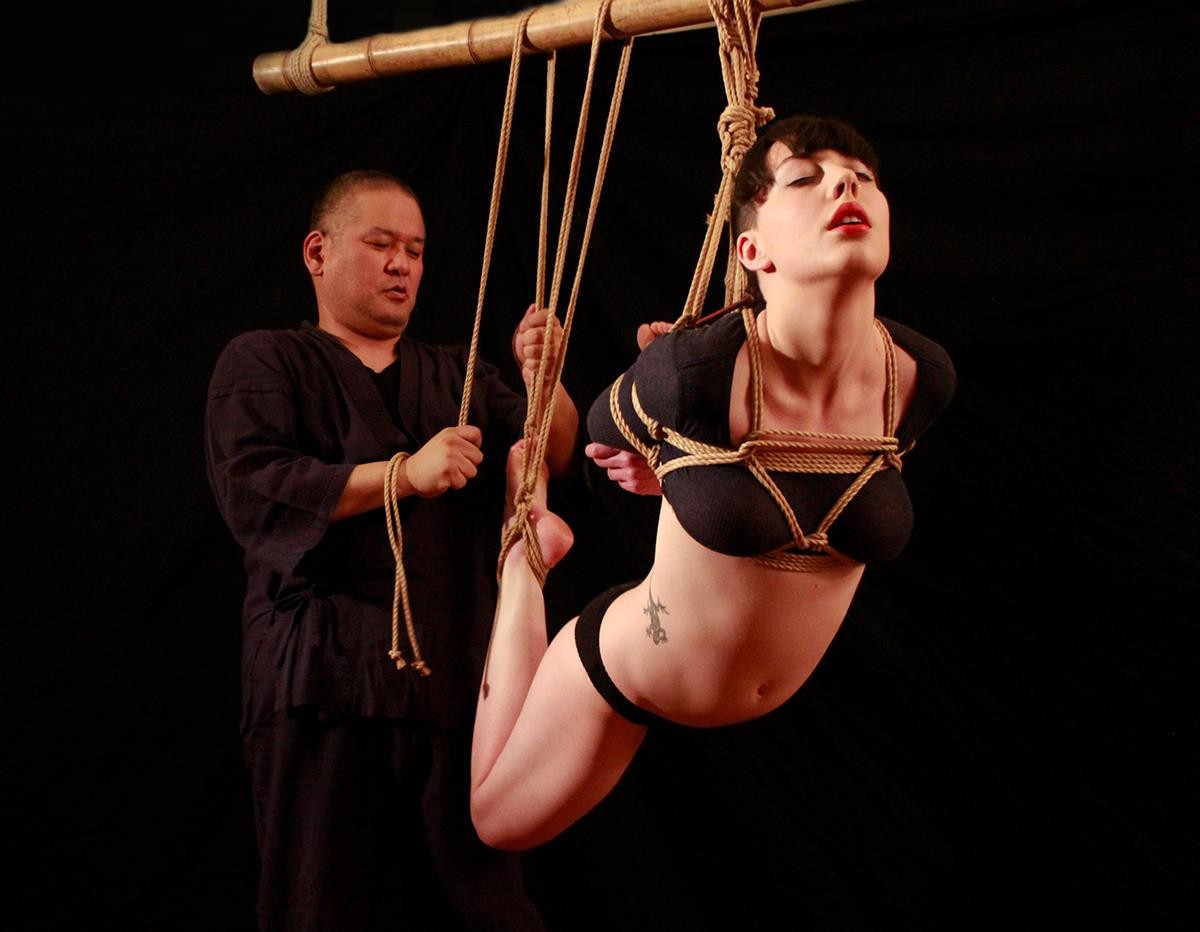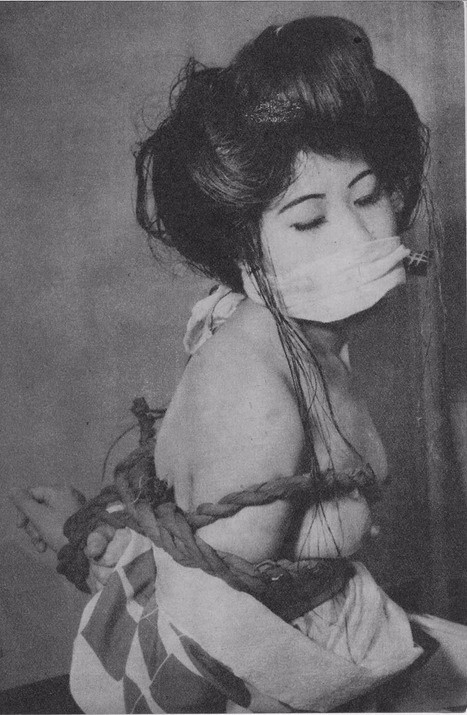What is shibari?

If you don't like reading
If you don't like reading, I recently made a video, entitled 'What is Shibari?', which attempts to answer this question. The answer, in short, is the definition of shibari will vary according to who you ask. At one end of the scale, you will find western rope bondage that has some slight Japanese influence and, at the other, the type of bondage performed by the professionals in Japan. Be aware these forms of bondage differ massively in aesthetics and philosophy. All that is important is you choose the version of shibari rocks your boat. Here's a bit of advice on "How can I learn shibari?" and about the different tying styles.
In the video below, I hope to show you what you could be missing by just learning pretty shibari patterns. The larger part is often unseen; the real secret of shibari is all about how you do it and the powerful effect that can have on your partner.
What is shibari?
Do shibari and kinbaku mean the same?
In simple terms, the answer to "What is shibari?" is that shibari, like kinbaku, is a name for Japanese rope bondage. To me and, quite probably, your partner, it is more important how it feels when they get tied than what you call the type of bondage. As they say, a rose by any other name would smell as sweet.
The first thing that might surprise you is it's that more about the 'how' the tying is done than just about how it looks. Like sex, a good shibari session is not merely mechanical. This trailer for The Pleasure of Rope from Bob Bentley on Vimeo will give you an unique glimpse into the world of shibari and give you a more authentic insight than random Googling 'shibari'.
The Pleasure of Rope
Defining shibari and kinbaku
I should start with a translation of the actual words before moving onto a wider discussion:
Shibari: The word shibari came into common use in the West at some point in the 1990's to describe the type of rope bondage popular in Japan known as kinbaku. Shibari is a Japanese word that literally means "to tie" or "to bind". See dictionary entry.
Kinbaku: The word kinbaku means 'tight binding' and, less commonly heard, kinbaku-bi which literally means 'the beauty of tight binding'. See dictionary entry.
Kinbaku is a Japanese style of bondage or BDSM which involves tying up the bottom using simple yet often visually intricate patterns, usually with several pieces of thin rope (typically and generally between 5mm- 6mm in diameter, but sometimes as small as 4mm, and between 7m–8m long).
In Japanese, this natural-fibre rope is known as 'asanawa'; their vocabulary does not make a distinction between hemp and jute so it is often thought to translate as hemp rope as we know it in the west. I can't say I have seen hemp used in Japan by any of the pro's, so, as you can see, translations aren't so simple.
If you really want to learn more about the definitions and difficulties in translation, read Osaka Dan's article 'My subjective view of kinbaku'.

Is there a difference between shibari and kinbaku?
There is much discussion about the distinction between shibari and kinbaku, and whether one term is more appropriate than another for this form of rope bondage. One modern distinction, probably originating from Osada Steve, which is gaining popularity among westerners wanting to distinguish the terms is that shibari refers to purely artistic, aesthetic rope bondage, whilst kinbaku refers to the artistic, connective, sensual, sexual practice as a whole.
While thousands of books and articles have been written in Japanese about shibari, no one has found evidence of there being any thought given to the distinction between these words among Japanese practitioners of the art. In fact, they seem fairly interchangeable and sometimes the word 'bondage', in English, is used.
A traditional view is that the term 'shibari' is a wrong Western Japonism. The word denotes tying in Japanese, but in a generic way, and traditionally not in the context of bondage. The names for many particular ties include 'shibari', but it is not traditional to call the entire activity that way. (In the same way as there are 'Diamond Knots' and 'Portuguese Bowline Knots', but 'knotting' does not mean bondage).
Instead, kinbaku is the term for artistic or erotic tying within traditional Japanese rope bondage circles.This view seems to be squarely at odds with the way the word is actually used in books, periodicals, and discussions of rope bondage among Japanese.
An even more traditional view is that shibari is a term used for erotic bondage in Japan that is practically interchangeable with the term kinbaku. Itoh Seiu, generally considered one of the fathers of contemporary Japanese rope bondage used the term in the 1950s,[2]with no sign of it being a "western Japonism" as did many other well known Japanese (kin)bakushi, from the 1950s until present day, including Nureki Chimuo, Yukimura Haruki, Akechi Denki, Tsujimura Takeshi, Arisue Go, Randa Mai, Osada Steve, Miura Takumi, Nagaike Takeshi, and Minomura Kou (among countless others). One of Nurkei Chimuo's how-to video series from the 1980s, is titled Introduction to Shibari.[3]

Some claim this is a somewhat hidebound definition and the word shibari is now increasingly being re-imported from the West to Japan, as the tying communities are very much interconnected. However, I have seen little evidence to support such a conclusion as most practicing bakushi in Japan have very limited contact with the west and almost no interest in debating the meaning of words. Most Japanese kinbakushi do not object to the term shibari, as it's common vernacular in the global community. Another explanation can be found in the linguistic roots of the two words, which share a core kanji.[4]
Westernised 'shibari' and Japanese style bondage
In the west, especially in America, the term shibari has also been extended to encompass many styles which are a fusion of western and Japanese bondage. Being somewhat pedantic, I feel this is inappropriate, confusing and typical of the differences between English and American English. This being so, the difference can be as great as between the meaning of 'football' to each nationality (Americans use this word to refer to a game closer to rugby and use 'soccer' for what we term 'football'). I prefer the term 'Japanese style bondage' to encompass westernised variants. Typically, the approach is characterised by being more about the destination, i.e. restraint prior to the 'main event' of sex or SM, than the journey.
It's not what you do, it's the way you do it
The ' how' is real secret of shibari as I discovered during my journey into this art which began in the late 90's. Fortunately, since my initial interest was sparked by an article about the more psychological aspects of Japanese bondage, this and the connective side of rope became my focus early on. Consequently, I coined the expression 'tying people, not parcels' and was one of the first westerners to widely evangelise this approach. Sadly, Nina and I feel a lot of people are missing out on the essence of shibari because they are only taught to create a tie in a 'paint by numbers' manner, not what creates the effect. This is something you will learn in our tutorials.
At first sight, shibari might seem complex but we break tying techniques down into simple 'ingredients' explaining not only how, why and where they are used but also how to create the best effect. These ingredients are the foundation of even the most complex 'recipes' (ties) making them easier to create correctly with confidence and to remember.
Aesthetics and rope types
The aesthetics of the bound person's position is important: in particular, Japanese bondage is distinguished by its use of specific forms and aesthetic rules. Sometimes, asymmetric and often intentionally uncomfortable positions are employed.
In particular, Japanese bondage is very much about the way the rope is applied and the pleasure is more in the journey than the destination. In this way the rope becomes an extension of the nawashi's hands and is used to communicate. I have often heard Japanese masters express this. same feeling in very similar ways.
Japanese bondage techniques typically use jute rope, albeit in days gone by rice straw rope was also used, though some deviate into less conventional materials, e.g. Kinoko Hajime's UV 'cyber-rope' shows, Yukimura's tenugui (cloth strips). The natural fibers easily lock to each other which means the bondage can be held together by the friction of twists and turns or very simple knots. Of course, I use the word 'traditional' loosely since today's recognisable form is relatively young. Here's an interesting podcast if you want to know more about the history of rope and restraint in Japan.
Shibari sounds great, so where do I start?
By now, you should have some idea of the various interpretations of shibari. If you want to learn connective shibari from some of the most experienced teachers online, look no further! We can offer you a very comprehensive guided course, 'Introducing shibari: Mega-bundle', offering two routes. One is a fast-track for those looking to learn a selection of ties for bedroom fun and the other has a more in-depth approach for more serious students. We also have our own groups on Fetlife and Facebook, where you can ask questions but there are many other shibari related ones.. Don't be shy, nobody bites...unless you ask nicely and get lucky!
What else do you need, apart from a willing partner, with whom you have negotiated consent? Obviously, some rope is essential. Don't get carried away.All you really need to get going is 2-4 lengths of 7-8m long, even one rope will do. It's all about the quality of your tying, not the quantity. Learn to use a little rope to good effect before adding more. It should become an extension of your hands and your will ;-)
Like many things, it is easier to do a good job with tools that are fit for the purpose. You can find a great selection at ESINEM-Rope, which I used to own but is now under new management. Choose a good budget or mid-range rope to start out. Don't spend a fortune; leave the fancy, light-weight, single yarn ropes till you are good enough appreciate them and not wreck them.
So, be safe but have fun!




